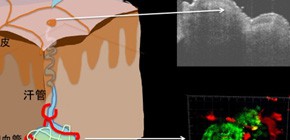
Histamine, a major player in allergic reactions, suppresses perspiration
important step in treating atopic dermatitis and dyshidrosis
Under the leadership of MUROTA Hiroyuki and MATSUI Saki (Dermatology Department, Graduate School of Medicine, Osaka University) a group of researchers has confirmed that histamine, involved in many allergic reactions, suppresses perspiration by directly observing sweating and sweat glands in vivo.
Sweat is one of the most aggravating factors in atopic dermatitis (AD). However, it is known that, if the amount of one's perspiration decreases and even if one feels sweaty, actually the amount of sweat necessary for regulating body temperature has not come out. As a result, the skin becomes hot, drying and losing its resistance to pathogens, aggravating the AD.
The cause of this compromised perspiration has not been known. This group expected to find that allergic factors influenced sweating. From the results of their research, this group confirmed that sweating, experimentally-induced by acetylcholine, was suppressed by histamine.
Optical coherence tomography showed sweat flow in the sweat duct when acetylcholine was administered; however, when histamine was administered, sweat did not come out. Through these findings, they concluded that histamine directly affected sweat glands. Two-photon excitation microscopy showed histamine working on sweat glands, impairing sweating. Their findings indicated that histamine activated glycogen synthase kinase in sweat glands, inhibiting sweating.
Abstract
Sweating has been associated with the exacerbation of atopic dermatitis (AD) in diverse ways. Acetylcholine-mediated sweating is known to be attenuated in AD, but its cause remains obscure. To address this issue, the impact of histamine on acetylcholine-induced sweating was evaluated. Sweating was measured by counting the number of active sweat pores by the starch-iodine reaction and dynamic optical coherence tomography; sweat was visualized using two-photon excitation fluorescence microscopy in mice and the quantitative sudomotor axon reflex test in humans. Both histamine receptor antagonists and H1 receptor (H1R)-KO mice were employed to determine methodological specificity. Histamine demonstrably inhibited acetylcholine-induced sweating in both mice and humans via H1R-mediated signaling. In sweat glands, acetylcholine inactivated glycogen synthase kinase 3β (GSK3β), a kinase involved in endocytosis and secretion, whereas simultaneous stimulation with histamine activated GSK3β. Results of two-photon excitation fluorescence microscopy confirmed the dynamic motion of sweat and sweat glands after acetylcholine-treatment, showing that simultaneous stimulation with histamine altered their dynamic properties. These results indicate that histamine inhibits sweat gland secretions via blocking acetylcholine-induced inactivation of GSK3β. Histamine-mediated hypohidrosis might be involved in the mechanism of abnormal skin dryness in patients with AD.

Figure 1

Figure 2
To learn more about this research, please read the full research report entitled " Dynamic Analysis of Histamine-Mediated Attenuation of Acetylcholine-Induced Sweating via GSK3β Activation " at this page of the Journal of Investigative dermatology website.
Related link :
